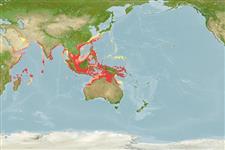Preferred temperature (Ref.
115969): 25.5 - 29.1, mean 28.1 (based on 1980 cells).
Phylogenetic diversity index (Ref.
82804): PD
50 = 1.0000 [Uniqueness, from 0.5 = low to 2.0 = high].
Bayesian length-weight: a=0.00513 (0.00361 - 0.00729), b=2.96 (2.86 - 3.06), in cm Total Length, based on LWR estimates for this species (Ref.
93245).
Trophic level (Ref.
69278): 4.4 ±0.89 se; based on food items.
Resilienza (Ref.
120179): Medio, tempo minimo di raddoppiamento della popolazione 1.4 - 4.4 anni (Assuming tm=2).
Prior r = 0.54, 95% CL = 0.36 - 0.81, Based on 9 data-limited stock assessments.
Fishing Vulnerability (Ref.
59153): High to very high vulnerability (73 of 100).
Climate Vulnerability (Ref.
125649): High to very high vulnerability (75 of 100).
